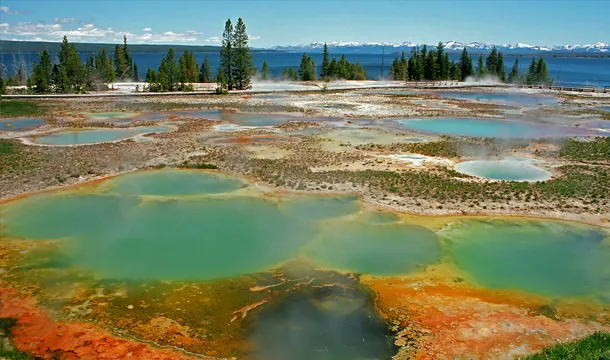
Yellowstone National Park
Wyoming, Montana and Idaho states. Yellowstone National Park is the oldest national park in the world. The park has famous geysers, hot springs, mud volcanoes, fumaroles and waterfalls.
The park is located on a vast volcanic plateau, under which, at a depth of 7-17 km (seismic measurement ) there is a magmatic chamber (72 km long, 30 km wide and 660 km deep ). Using magnetotelluric diagnostics, it was found that 300 km underground are also highly molten rocks . In the past (over 2 million years, 1.3 million years and 640 thousand years) there was an explosion of a supervolcano in this place, which caused huge and extensive destruction. The National Park is dissected by the deep gorge of the Yellowstone River. Through the Park it passes continental waters of America . In 1978, Yellowstone Park was added to the UNESCO list of world cultural and natural heritage. A biosphere reserve has also been established here
The history of the Park
The area of the Park was inhabited by indigenous people from at least 11,000. years, while the first white were members of the Lewis and Clark Expedition, which took place in 1804-1806. They found the presence of Indians from the Nez Percé, Wrony and Szoszoni tribes. Due to the natural and geological uniqueness of the United States Congress, signed by President Ulysses Grant, a special decree created the National Park on March 1, 1872 [6]. One of the hot proponents of creating the Park was the American geologist Ferdinand Hayden, whose name was later named one of the larger valleys. Initially, the park was protected by a regular army unit stationed in the northern part of the park in Mammoth Hot Springs, and from 1917, a year after the creation of the national parks' institutions, the National Park Service took care and administration.
Flora
An ordinary candle of 1100 species of vascular plants. 2/3 of forests in Yellowstone are taken by coniferous forests. In the seventies of the twentieth century, In the 80s area of coniferous forests. In the park there are also 186 species of lichens, as well as about 200 alien species. More than 400 thermal watermelon logs have been cataloged, but up to now only 1% hydrothermal treatments
Fauna
Yellowstone National Park is widely recognized as the best megafauna environment in the continental US. 67 species of mammals live here, including the gray wolf introduced in 1995 [9], the Canadian lynx threatened in the United States, and the grizzly bear [8]. Other large mammals whose population is significant are American bison, baribal, wapiti, elk, mule deer, horned deer, snow goat, fork lift, Canadian mouflon and puma.
Yellowstone is the only place in the continental United States where the wild bison population has survived. In 1902 there were only about 50 of them. For fear of extinction and genetic depletion, the flock was supplemented by 21 animals from private herds. Together, they formed the basis for a 50-year project to rebuild this species on the Buffalo Ranch in the Lamar Valley. Supportive activities, consisting of feeding, irrigating pastures, sprouts, shooting sick animals, and controlling predators slowly led to the rebuilding of the herd. From the 1920s, the population began to grow and animals in 1936 were transferred to the natural environment around the River Firehole and the Hayden Valley. In 1954, the population was 1,477 units. After a period of decline in the 1960s, the population would increase, and from 1996 the herd population would permanently exceed 3500 individuals
Climate
The climate of Yellowstone is determined by the location above sea level (average level is 2400 m above sea level), whose amplitude is between 1610 m above sea level. (Reese Creek) and 3462 m above sea level, (Eagle Peak) [8]. In lower regions, the average annual temperature is clearly higher. So far, the highest recorded temperature was 37 ° C in 2002 at Mammoth Hot Springs, while the cold record was recorded in 1933 near the Riverside station where -54 ° C was found [8]. In the summer months, the daytime temperature usually ranges from 21 to 27 ° C, but at nights, especially at higher altitudes, it can drop even to temperatures below 0 ° C. In the summer, especially in the afternoons, violent thunderstorms often occur. In spring and autumn daily temperatures range from -1 to 16 ° C, with cold nights (-5 to -20 ° C). Winters are very cold with maximum temperatures of -20 to -5 ° C and with nights below -20 ° C for almost the entire period [11].
Precipitation in the Park is characterized by a large diversity depending on the location. The lowest annual rainfall is observed at the northern boundaries of the Park and is only 260 mm, while in the south-eastern corner of the Park, rainfall of over 2,000 mm has been observed. Such high rainfall causes the inflow of moisture through an air channel along the valley of the Snake River. Snowfall can occur at any time of the year. The maximum snow cover is thick and ranges from 380 cm (area of Yellowstone Lake) to over 600 cm (in high places). The average annual snowfall is 183 cm [.
Yellowstone tornadoes are rare. However, on July 21, 1987, the strongest tornado recorded so far in Wyoming reached the park through the Teton National Forest. It was classified as the fourth degree tornado (F4) and the wind speed was estimated to be between 333 and 420 km / h. Tornado left a strip of damage from 1.6 to 3.2 km wide and 39 km long and laid down 6100 ha of forests